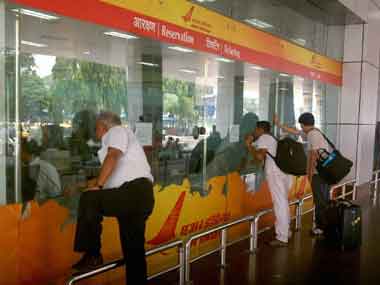New Delhi: If Japan Airlines can come back from bankruptcy and sky-high losses to profitability in one year flat, why can’t Air India?
This is what Civil Aviation Minister Ajit Singh wanted to know from the 22 representatives of Air India employee unions who met him on Monday. Since the Indian Pilots’ Guild (IPG), which is spearheading the current strike, was not part of the meeting, a whole lot was not said on the IPG pilots’ agitation. The minister merely repeated his stand that pilots must first join back duty before negotiations can begin.
[caption id=“attachment_316661” align=“alignleft” width=“380” caption=“PTI”]  [/caption]
But an hour after the meeting got over, the Air India management quietly terminated the services of 30 more striking pilots, taking the total terminations to 101 since the strike began on 7 May. This, despite two IPG pilots joining back work on Monday morning.
Citing the example of JAL, which turned profitable within one year (profit of Rs 12,000 crore in 2011 against a loss of Rs 1.2 lakh crore in 2010), Singh sought employees’ cooperation in completing the integration of erstwhile Air India and Indian Airlines. He also assured them that among their demands, the current freeze on promotions within the organisation would be lifted soon.
And unlike the JAL turnarournd, which saw many thousands of employees lose their jobs, no one would be asked to leave Air India as part of downsizing, the minister assured employee representatives. The two erstwhile carriers were merged in 2008 when the employee strength was around 34,000; it has fallen to 27,000 through natural attrition and another about 7,000 employees are expected to retire in about three years.
Impact Shorts
More ShortsEmphasising the benefits of merger, the minster made it clear that there will be no reversal of the process and instead employees of the two erstwhile carriers must learn to work together.
Emerging from the meeting, Arun Kumar Malhotra of the Air Corporation Employees Union (ACEU) said his union had pressed for abolition of the concept of performance-linked incentives (PLIs) and this component should be merged with basic salary. The ACEU claims to represent 17,000 AI workers such as ground staff, sweepers, and traffic assistants at airports. Before the two airlines were merged, employees of the erstwhile IA would get PLIs if at least 19,000 seats were filled across the airline in a day, allowing it to break even.
Malhotra claimed that breakeven of the merged entity does not happen even when 40,000 seats are filled in a day.
Since the non-licensed staff of the airline account for roughly about 80 percent of the total employee strength but only about 20 percent of overall salary disbursal, the move by ACEU would hit pilots and other licensed category employees the most. In many cases, PLIs of the licensed staff is multiple times their basic salary.
Malhotra also insisted on “Cross Integration” of all classes of employees of the two erstwhile carriers, another demand which is sure to irk the pilots.
Meanwhile, Ajit Singh indicated that before implementing the Dharmadhikari Committee report, the government was ready to discuss its implication with the employees. The Dharmadhikari committee has recommended a Voluntary Retirement Scheme (VRS) to prune the workforce at Air India, implementation of a concept of ’no work, no pay’ and comprehensive analysis of the pay structure across the airline to bring it on a par with other public sector units. The airline wants to save Rs 200-250 crore in annual salary payment by abolishing fixed allowances and PLIs.
Not just pay rationalisation, the Dharmadhikari panel has also proposed “cross utilisation” of pilots from the erstwhile AI and Indian Airlines - something the IPG is obviously not happy about. This means neither set of pilots gets monopoly over a particular aircraft type or on international routes. The airline is already gearing up to computerise pilot duties - something which till now has been done manually and usually at the behest of pilot unions. This will also mean that erstwhile AI pilots lose their hegemony over lucrative long-haul flights to Europe and USA.


)

)
)
)
)
)
)
)
)



